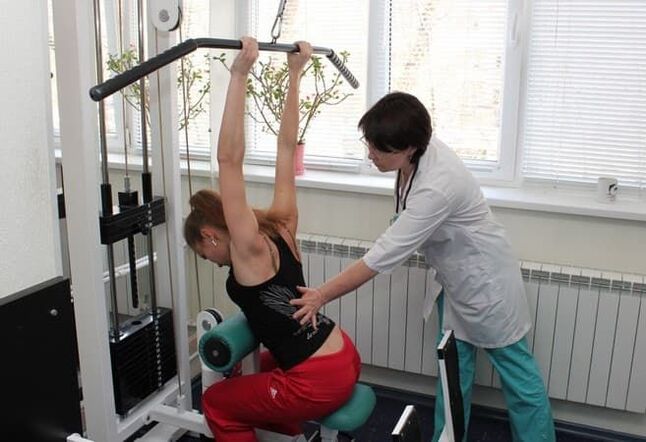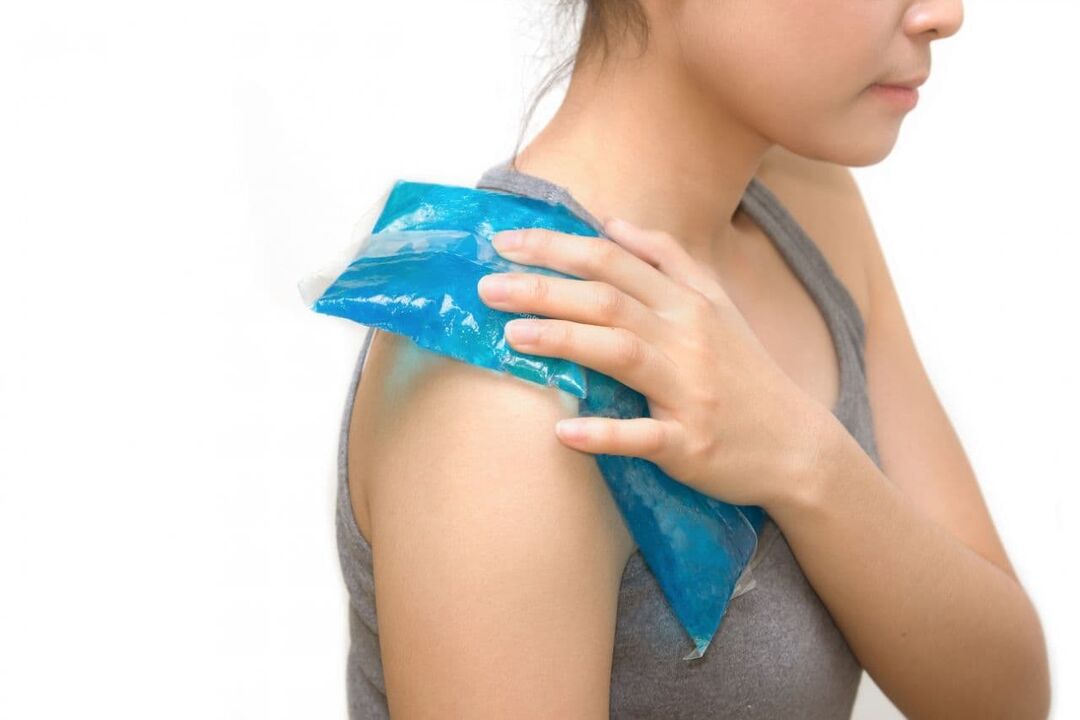Arthrosis (osteoarthritis) is a degenerative disease of cartilage tissue in which the normal functioning of the joint is disrupted. In most cases, the disease is chronic. Shoulder arthrosis is characterized by pain and a gradual loss of hand function. Pathology is most commonly detected in old age. The causes of osteoarthritis are changes in the body in old age, shoulder injuries, birth defects and constant strain on the shoulder girdle. If a person experiences discomfort in the shoulder girdle, a doctor should be consulted and examined. The complex effect can be used to stop the development of degenerative lesions.
What is shoulder joint arthrosis
Shoulder arthrosis - damage to the cartilage tissue of the joint, during which degenerative changes occur. The cartilage tissue loses blood supply and therefore does not get enough nutrients and oxygen.People who are exposed to excessive stress on the shoulders on a daily basis and have congenital abnormalities in the joint tissues are at risk.In the early stages, the person experiences aching pain, but normal shoulder function is maintained. If the provoking factors are not eliminated, the disease will cause serious damage to health.
Diagnosis plays an important role in the treatment of arthrosis. An X-ray can be used to pinpoint the cause of the disease and the extent of the damage.
Anatomical background
Congenital disorders of the joints and connective tissue structure may be the cause of the disease. If a person has features in the structure of the shoulder girdle, even an ordinary load can provoke the appearance of arthrosis. You should take preventative measures and see a doctor regularly to avoid problems. Congenital dysplasia can be controlled with massage and movement therapy.
Causes and risk factors
Every elderly person is in danger.According to WHO statistics, the likelihood of developing arthrosis increases significantly after 45 years.By the age of 65, more than 50% of people suffer from this disease. Causes of early onset of the disease include:
- injury to the rotating shoulder cuff;
- shoulder injury;
- constant stress related to sports or work;
- infectious and autoimmune pathologies;
- obesity;
- inadequate metabolism.
The older a person is, the greater the risk of developing degenerative joint damage.
Views
The defeat of cartilage tissue is divided into primary and secondary. Primary arthrosis is diagnosed when there are no comorbidities. It is usually detected in old age. The reason for its appearance is age-related changes. The secondary view occurs due to injuries or in the background of another disease. In addition, the disease is classified by location.Degenerative changes in the shoulder can occur in the shoulder joint itself or in the acromioclavicular joint.
Developmental stages and symptoms
The symptoms depend on the stage of development of the arthrosis of the shoulder joint. The pathology is divided into three stages:
- The first. . . There are aching pains that intensify at night, the shoulder girdle functionality is maintained.
- The second. . . When the hands are moved, a crack is heard, the pain is constant, the movement of the shoulder is restricted.
- Third. . . Severe pain, the arm is fixed in one position, protrusions are visible in the affected area, a strong deformation of the joint can be seen on the X-ray.
The disease cannot develop for a long time. If a person continues to strain the shoulder girdle, his condition deteriorates.
Which doctor to go to
Shoulder joint arthrosis is treated by various doctors. The first test is performed by a therapist or rheumatologist. In addition, the following professionals may be involved in the treatment:
- surgeon;
- orthopedic doctor;
- neurologist.
In most cases, the treatment regimen is drawn up by a rheumatologist.The assistance of a surgeon is required if the disease requires surgical treatment or intraarticular manipulations.Consultation with a neurologist is required if the nerve bundle is compressed due to the disease.
Only after the diagnostic test does the therapist or rheumatologist determine if the help of other professionals is needed.
Diagnostics

Hardware and laboratory tests as well as manual tests are used to make an accurate diagnosis. Above all, they check with various tests. They study the person’s history. All this helps to make a preliminary diagnosis. In addition, MRI and X-ray are used to determine the extent of joint space narrowing, the condition of blood vessels, synovium, tendons.
Manual examination
Manual examination includes palpation of the affected area and performance of diagnostic tests. Pain usually occurs when the acromioclavicular joint is palpated. If someone has trouble placing their hands behind their head, this may indicate the presence of arthrosis of the shoulder joint. During the manual examination, the doctor will be able to detect the inflammation. The information obtained during the manual examination plays an important role in the diagnosis.The test should be performed by an experienced rheumatologist or therapist so as not to cause harm during testing and functional examinations.
Instrumental methods
Instrumental research methods make it possible to determine:
- the degree of narrowing of the joint gap;
- uneven joint surface;
- localization of arthrosis.
After using instrumental diagnostic methods, the required therapy is selected. Radiography, CT, or MRI are used for diagnosis. These methods provide the necessary information. The instrumental test may be repeated during treatment.

Laboratory
Laboratory tests make it possible to assess the condition of the body as a whole and to rule out inflammatory arthritis. First, they take blood for analysis. In case of arthrosis, all indications of clinical and biochemical blood tests are within normal limits. In arthritis, there is a significant increase in the rate of erythrocyte sedimentation, immunoglobulins and other markers of the inflammatory process in the body. Based on the results obtained, the doctor makes a final diagnosis and chooses an effective treatment regimen.
For accurate results, give blood on an empty stomach in the morning.
Treatment
The approach to treatment is complex. They use drugs, physiotherapy, physiotherapy practices. If the disease is advanced or does not respond to treatment, surgery is used. Principles of therapy:
- relieves pain;
- stop the development of the disease;
- trigger cartilage tissue repair mechanisms.
In the initial stage, the result is achieved by using drugs.It is important to exclude provocative factors. Stable remission can be achieved with physiotherapy and gymnastics.
Medicine
The following groups of drugs can be used for treatment:
- non-steroidal anti-inflammatory drug;
- chondroprotectors;
- corticosteroids;
- vasodilators.
NSAIDs and corticosteroids are used to relieve pain. They apply for a limited time. Chondroprotectors can accelerate cartilage tissue recovery. Vasodilators improve blood flow and relieve cramps in small blood vessels.
Before prescribing this or that medication, you should carefully study the contraindications. Only a doctor can combine all medications correctly.
Surgical
Surgery is performed only as a last resort if irreversible degenerative processes occur. The reasons for this operation are as follows:
- lack of effect of conservative therapy;
- incidence of complications;
- appearance of severe degenerative lesions.
If the joint has lost its original appearance, arthroplasty should be performed.The diseased joint is replaced with an artificial one. Surgery is complex and requires a high level of professionalism from the surgeon. Puncture and arthroscopy can also be performed to treat arthrosis.
Thrust
The puncture is performed when a large amount of fluid has accumulated in the joint cavity. This procedure is also performed with infectious inflammations to determine the type of infection. Getting rid of excess fluid helps reduce pressure on the shoulder joint and increase its mobility. The procedure is minimally invasive, so recovery after completion will occur as soon as possible. Puncture has indications and contraindications. It should only be used if fluid has accumulated in the joint capsule or if an infectious complication of arthrosis is suspected.
Arthroscopy
Arthroscopy is a minimally invasive surgical technique that removes damaged shoulder cartilage. The surgery is performed with an endoscopic device and a microcamera. The advantage of this method of treatment is rapid rehabilitation. Removal of destroyed cartilage makes it possible to relieve stress and restore joint mobility. The disadvantage of this procedure is that access to the area concerned is somewhat limited.
Endoprosthesis
Endoprosthetics is the complete replacement of a damaged joint with a biocompatible analog.Titanium construction is often used. The operation allows you to get rid of even stage 3 arthrosis. Long-term rehabilitation is performed after the endoprosthesis. As a result, complete removal of the affected areas and chronic pain as well as shoulder girdle mobility can be achieved.

This operation is not always possible. In the elderly, the rehabilitation period is much more difficult. Other treatment options are used before the appointment of arthroplasty.
Physiotherapy
Physiotherapy procedures play an important role in getting rid of shoulder girdle arthrosis. They can help restore normal joint mobility and reduce the severity of pain. The following procedures are performed:
- electrophoresis;
- local cryotherapy;
- magnetotherapy.
Physiotherapy can be used if there are no acute manifestations of the disease (severe pain, limited mobility). Regular exposure completely eliminates the discomfort. All procedures must be performed by a qualified technician.Consult your doctor before visiting the physiotherapy rooms.
Physiotherapy

Physiotherapy involves the use of active and passive methods to restore shoulder function. If the disease is mild, the person can start using the active healing method through exercise. The passive method is external exposure with massage or mechanotherapy. Kinesitherapy helps to quickly get rid of the manifestations of shoulder joint arthrosis.
A passive method of mechanotherapy healing is available for any age group.
Practice therapy
Physiotherapy exercises allow the muscles to be loaded and the mobility of the shoulder joint to be restored. Static exercises are mostly used. The dynamic load in which active shoulder rotation occurs is undesirable. The following exercises can be performed:
- Swinging shoulders- the starting position should be taken by sitting in a chair and placing your hands on your knees. Loosen your shoulders and then start swinging your elbows. However, the hands are on the knees.
- Slow rotation- you should sit down in a chair and put your hand on your knee, then slowly, with short breaks, start rotating your shoulders. The circular movements are performed back and forth.
Physiotherapy can only be used during remission, when pain and limited mobility are almost completely absent.

Massage
Massaging the affected area allows the following effects to be achieved:
- improves tissue nutrition;
- relieves swelling;
- tones the muscles;
- remove the pain.
We recommend that all operations be performed by a qualified professional.When performing a self-massage, strong pressure and sudden movements should be avoided.The effect of the massage is noticeable within a few weeks after regular use.
The massage should be accompanied by other activities. If someone is doing exercises from the gym therapy complex and visiting a massage room, they will achieve great results.
Mechanotherapy

Mechanotherapy is a series of exercises that are performed on special mechanisms. This method allows recovery in the shortest possible time. Mechanotherapy is ideal for postoperative rehabilitation. Special mechanisms allow the load to be adjusted, allowing muscles and ligaments to recover faster. All operations are performed under stationary conditions. Classes on rehabilitation mechanisms should be conducted with an instructor. You select the correct load and the required simulator correctly.
Traction of the joints
The joints are stretched with a special device. The following effects can be achieved with this procedure:
- improves blood circulation;
- increase joint space;
- relieves tension from the tapes.
Narrowing of the joint space is one of the main manifestations of arthrosis. You can use this procedure to improve the situation. The load level is selected individually. Initially, towing is done with minimal weights.
Any contraindications should be investigated before prescribing joint traction.
Folk methods
Traditional methods allow you to get rid of pain and speed up the process of cartilage tissue recovery. The following remedies are available:

- Burdock leaves- crush the fresh burdock leaves until soft and apply them to the affected area for 30-60 minutes. The fixation is done with gauze.
- Salt compress- Dissolve 50 g of salt in 450 ml of water and place gauze in the liquid. The gauze is removed, heated and placed on the shoulder for 45 minutes.
- gelatin- Dilute 2 teaspoons of gelatin in 100 ml of warm water and bring to the boil. Gelatin should be taken orally once daily before meals. Helps to restore cartilage tissue.
Traditional methods help to achieve good results in therapy. It is recommended to use them during remission.
Diet for arthrosis
For any type of arthrosis (shoulder, wrist, ankle), you need to supply your body with all the nutrients to quickly restore cartilage tissue. You should add the following foods to your diet:
- nuts;
- bran;
- gelatinous gel;
- buckwheat porridge;
- egg.
The diet should be balanced. Vitamin supplements can be taken to get essential vitamins and minerals. It is advisable to eat 4-5 times a day. Alcoholic beverages and sweets are excluded during the treatment of arthrosis. If one wants to achieve lasting remission, one must constantly adhere to the principles of proper nutrition.
Complications and prognosis
The prognosis depends on the person's age, the degree of damage, and the individual characteristics of the body. At a young age, it is possible to completely restore cartilage tissue and joint functions. In old age, you must follow certain rules in order for your condition to improve permanently. Shoulder arthrosis responds better to therapy than foot arthrosis because the shoulder girdle can be easily separated from stress. This allows for more effective conservative management.
Differences Between Shoulder Arthritis And Arthritis
Arthrosis and arthritis have the same manifestations but differ in the clinical picture. The main difference is that arthrosis is not an inflammatory disease.In the early stages, the pain of arthrosis only worries a person after training, and in arthritis it is constant.Arthritis is an inflammatory-degenerative disease. Its treatment is somewhat different from that of arthrosis.
In order not to confuse these diseases, differential diagnostic methods are used. Laboratory and instrumental tests help to accurately determine the presence or absence of inflammation.
Prophylaxis
Prevention of arthrosis consists of eliminating provocative factors and maintaining a healthy lifestyle. You need to do the following:
- provides moderate physical activity;
- avoid hypothermia;
- use chondroprotectors;
- avoid hard physical work;
- reduce body weight to normal.
Preventive measures help maintain joint health until old age. Prevention should be followed especially by those over 45 or active athletes.
conclusions
- Shoulder joint arthrosis is a degenerative disease in which the cartilage tissue of the joint undergoes gradual destruction.As a result, the person is in pain and has limited movement.
- Treatment of the disease includesapplication of medications, performing physiotherapy, and performing exercises from a complex of physiotherapy practices.
- The prognosis of complete recovery in the early stages of the disease is favorable.
- Prevention can significantly reduce the likelihood of shoulder joint arthrosis.

























